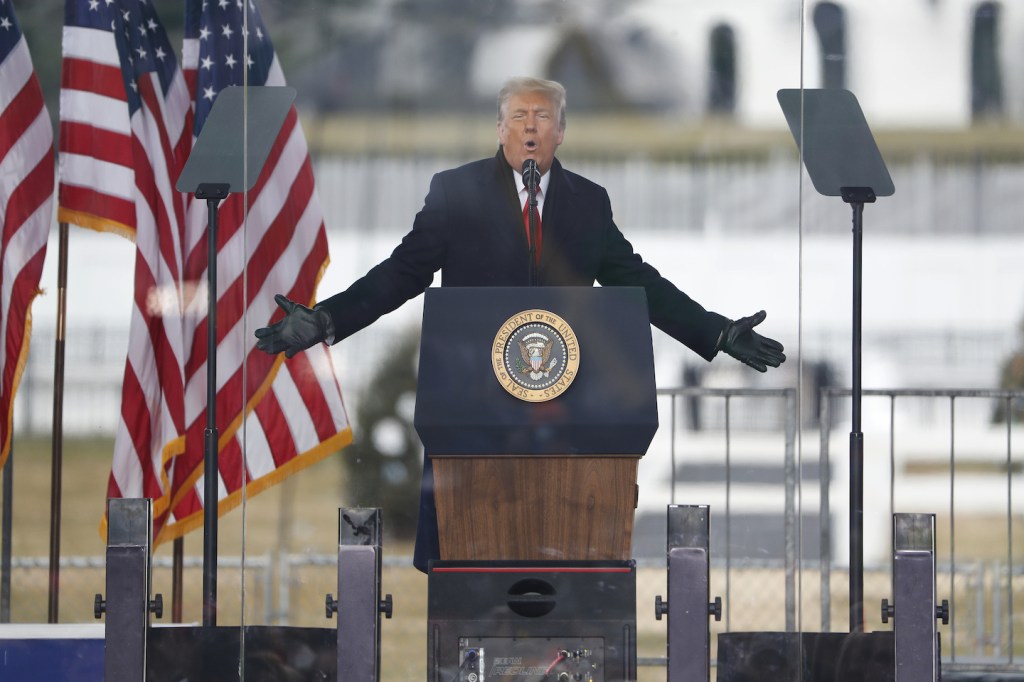Social media has a way of disrupting the best laid plans. As rioters stormed the capitol building on January 6, members of Congress took shelter in various locations throughout the building. At four minute before 5, when rioters were still in and around the Capitol building, Senator Jeff Merkley (D-OR) tweeted a picture that gave away his location.
“Electoral college ballots rescued from the Senate floor,” Merkley said in his tweet that showed a picture of the ballots and the feet of several people milling on a blue carpeted floor. “If our capable floor staff hadn’t grabbed them, they would have been burned by the mob.” It’s great that quick thinking staff thought to preserve the electoral votes, but Merkley inadvertently shared their new location while the crisis was ongoing.
Videos by VICE
If the rioters had been paying attention, they could have used the image to figure out where in the building Merkley had tweeted from. It took another observer about 20 minutes to pinpoint the location of the electoral ballots.
“That’s a really distinctive blue carpet,” Jeffrey Lewis, Director of the East Asia Nonproliferation Project at the Middlebury Institute of International Studies, told Motherboard over the phone. Lewis is an expert on nuclear war, an area of study that’s given him a familiarity with Capitol Hill, knowledge of U.S. disaster related continuity of government plans, and skills at open-source intelligence analysis.
The U.S. Government maintains a set of plans it is supposed to deploy when a crisis hits. The idea is to maintain a continuity of government—the ability for elected officials to continue to do their job and preserve the Union to the best of their abilities. In the decades after World War II, this meant preparing for a nuclear disaster and ushering congress into a bunker at the Greenbrier Resort in West Virginia.
The Washington Post exposed the bunker to the public in 1992 and Washington had to make new plans for what to do with Congress in the event of an emergency. According to Lewis, that new location is the Fort McNair Army base south of the Capitol. Some early reporting indicated that this is where law enforcement had taken Congress.
“It didn’t quite look like Fort McNair,” Lewis said of Merkley’s tweet. “I know they overran the Capitol, but there are several House and several Senate buildings and I suspected that maybe these yahoos didn’t quite realize that.”
According to Lewis, narrowing down the room based on the carpet was trivial after he realized Congress wasn’t at Fort McNair. “If I was trying to find those people and kill them…when I looked at that picture, I knew to go to the Hart Building and I knew to go to the hearing room,” he said. “And I figured that out in about 20 minutes.”
A better organized group of rioters could have used Twitter to find the locations of the Representatives and the electoral votes. It’s happened before in similar circumstances. In 2008, terrorists killed more than 166 people in Mumbai over the course of three days. Residents of Mumbai took to Twitter to share information about the attacks and the attackers watched Twitter to coordinate their efforts and avoid detection by first responders.
It happened again in 2013 when terrorist group Al-Shabaab attacked the Westgate Mall in Nairobi, Kenya. While the terrorists laid siege to the mall over three days, they tweeted about it and coordinated efforts via Twitter, including monitoring government services and civilians sharing information on the platform. “This kind of information may endanger the lives of the responders, and might have contributed to the prolonged siege, as the terrorists received live information detailing the armed response against them and were able to use this information to enhance their response,” researchers said in Twitter in the Cross Fire, an academic study of the use of social media during the attack
Today, our strategy for coping with a disaster is only as strong as the willpower of one Senator not to tweet out their secure location during said disaster. “These plans that make so much sense on paper are usually fiascos in real life,” Lewis said. “In a lot of cases, planning is about believing in a fantasy.”
Lewis said that studying nukes and nuclear crises constantly forces him to evaluate disasters and backup plans. “No plan survives first contact with the enemy,” he said of the lessons he learned from the siege of Capitol Hill. “But also, don’t tweet from secure locations.”




